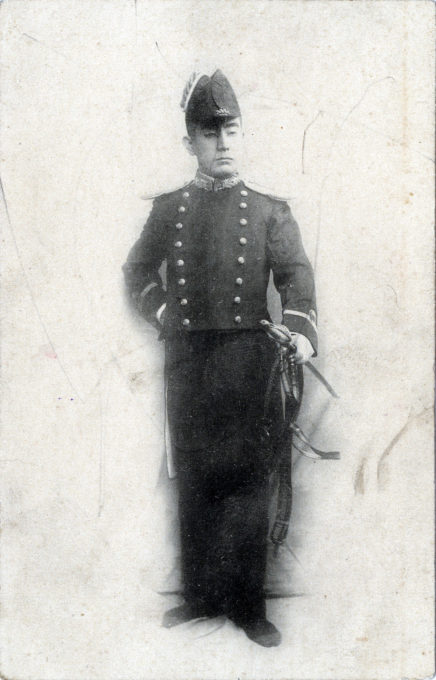
Imperial Japanese Navy officer’s dress uniform, c. 1905. This officer is holding a sword and scabbard with a colored tassel indicating his rank. Until 1872, there were no regulation naval swords and officers regularly carried a traditional katana tucked into their leather service belt. The first true Imperial Japanese naval sword was a copy of the British naval saber, issued to officers and marine NCOs, with deck officers and flag officers boasting more elaborate versions including gilded brass mounts.
See also:
Propaganda postcard reproduction of a 35th Army Day poster, March 10, 1940.
“This is the Japanese greatest admiral …”, Admiral Togo, 1906.
“Life in the Navy” postcard series, c. 1930.
The Imperial Japanese Navy underwent significant changes during the Meiji Period (1868–1912), particularly in its officers’ dress uniforms, reflecting Japan’s modernization and growing military aspirations.
Japanese navy officers’ uniforms in the early Meiji years (1868-1880) were heavily inspired by British and French naval dress, reflecting the nation’s goal to match the Western powers.
Uniforms initially featured a simple, high-collared tunic with a prominent line of buttons. Officers wore a round, brimmed cap, akin to British naval officers’ caps of the time, featuring a badge displaying the Imperial Chrysanthemum emblem.
Beyond the 1880s, the I.J.N. began formalizing its uniforms, leading to increased standardization across ranks. The British Navy served as a primary model. Officers wore dark blue or black tunics with gold braid detailing on cuffs to denote rank, brass buttons, and high collars. Dress uniforms for formal occasions included gold epaulettes, which were becoming increasingly elaborate.
By the end of the Meiji period (1900-1912), the I.J.N. officer uniform had evolved to balance Western styling with uniquely Japanese elements, symbolizing Japan’s emergence as a world power after victories in the First Sino-Japanese War (1894-1895) and the Russo-Japanese War (1904-1905).
Dark blue or black wool remained standard for formal wear, but seasonal adjustments were introduced, allowing lighter materials for summer wear, especially in warmer climates. Officers wore peaked caps with larger, more ornate insignia.
A sword, symbol of both traditional samurai and military honor, became a standard accessory for all officers, worn with a sword knot that varied in color and design by rank.

